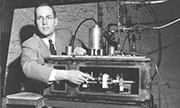E-Archive
Off the Beaten Track
in Vol. 20 - July Issue - Year 2019
On A Park Bench

Charles Townes in 1955 with his MASER
“One morning early before the meeting I went out in the park and sat down on a bench. I was wondering why we hadn’t been able to do this and what might be needed… I quickly pulled out a piece of paper and figured out what was needed… It all occurred, I would say, in about 15 minutes. It was one of those storybook cases.”
*****
Charles H. Townes was born in Greenville, South Carolina in 1915. He was a precocious student. He was so good at school that he complained to his parents that he was bored because he wasn’t feeling challenged enough. At their suggestion, he skipped his last year of high school, took some college courses during the summer of his fifteenth year, and was accepted into college at the age of sixteen. Three years later, he had his first university degree in physics. His parents thought he was too young to leave home, so he stayed an extra year and got another two degrees in modern languages plus Greek and Latin. Natural history and biology were his favorite subjects as a child, but at university, he discovered that his real passion lay with mathematics and physics. His interest would lead him to create one of the greatest inventions of the twentieth century – the laser.
The laser would not have been possible without some brilliant intuitions by researchers in the early 1900s. The German physicist Max Planck was the first to realize that light is a form of electromagnetic radiation. While working in thermodynamics, in 1900, he established the relationship between energy and the frequency of radiation. He stated that energy could be emitted or absorbed only in discrete chunks – which he called quanta – even if the chunks were very small. His discovery of elementary energy quanta earned him the Nobel Prize for physics in 1918.
Inspired by Planck’s theories, in 1905, Albert Einstein published a paper on the photoelectric effect, which suggested that light also delivers its energy in discrete quantum particles, now called photons. In 1917, he proposed the stimulated emission process whereby electrons could be stimulated to emit light of a particular wavelength. Scientists were able to prove this theory only several decades later.
Research languished during two world wars and due to a lack of appropriate equipment. In 1951, the Russian physicist Valentin Fabrikant’s application for a patent for “a method for the amplification of electromagnetic radiation” was at first rejected, only to be approved in 1959, when others had already developed and patented similar methods.
After receiving his Ph.D. in physics in 1939, Charles H. Townes was employed by Bell Laboratories, where he spent his first year happily engaged with basic physics research. This ended abruptly with the war, when he was assigned to develop military equipment – particularly radar navigation and precision bombing systems. Although he did not like this type of work, it gave him the opportunity to study the application of microwaves for the development of very high-resolution spectroscopy. This would prove useful for the later development of laser.
In January 1948, Townes left Bell Labs and went to Columbia University. He joined a team of professors working on high-resolution spectroscopy. This team included three Nobel Prize recipients and was supported by the military. It was known that the shorter the wavelengths, the higher the resolution, but going below the 1.25 cm wavelength with which Townes worked while at Bell Labs proved very difficult. To get down to wavelengths of a millimeter or fractions of a millimeter, the team had to come up with something radically different. They worked for over three years, but were stumped.
In an interview many years later, Townes described how his moment of inspiration came while sitting on a park bench. It was a balmy spring morning in April 1951 and suddenly everything became clear. Three years later, Townes presented his MASER (an acronym “for Microwave Amplification by Stimulated Emission of Radiation”) and the predecessor to the laser. The MASER amplified microwave radiation rather than the infrared or visible radiation amplified by laser, but was incapable of continuous output.
Over the following years, several scientists elaborated on Townes’s invention. Gordon Gould, a graduate student at Columbia University, published the term LASER, an acronym for “Light Amplification by Stimulated Emission of Radiation”, although the first functioning laser was presented by Theodore H. Maiman in May 1960.
In 1964 the Nobel Prize in Physics was awarded jointly to Charles H. Townes, Nikolay Basov and Aleksandr Prokhorov "for fundamental work in the field of quantum electronics, which has led to the construction of oscillators and amplifiers based on the maser–laser principle".
By Giovanni Gregorat, Contributing Editor MFN



























